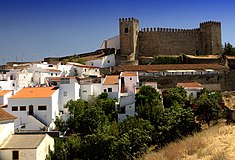Campo Maior Castle
| Castle of Campo Maior (Castelo de Campo Maior) | |
| Fortification (Fortaleza) | |
|
An emblematic image of the Castle and the small houses around its hilltop flanks
|
|
| Official name: Castelo de Campo Maior/Fortificações de Campo Maior | |
| Named for: Campo Maior | |
| Country | |
|---|---|
| Region | Alentejo |
| Subregion | Alentejo |
| District | Portalegre |
| Municipality | Campo Maior |
| Location | São João Baptista |
| - elevation | 275 m (902 ft) |
| - coordinates | 39°0′39.80″N 7°4′19.37″W / 39.0110556°N 7.0720472°WCoordinates: 39°0′39.80″N 7°4′19.37″W / 39.0110556°N 7.0720472°W |
| Architects | Diogo Lopes de Sepúlveda, Luís Serrão Pimentel, Manuel de Azevedo Fortes, Nicolau de Langres, Rossetti Architects, Carlos Lassart, João Pascácio Cosmander |
| Styles | Medieval, Renaissance |
| Materials | Quartzite, Granite, Schist, Tile, Calcium Oxide mortar, Stone, Clay |
| Origin | c. 1230 |
| - Initiated | c. 1310 |
| Owner | Portuguese Republic |
| For public | Public |
| Visitation | Closed (Mondays and on 1 January, Easter Sunday, 1 May and 25 December) |
| Easiest access | Estrada Nacional E.N.371, I.P. 373 |
| Management | Instituto Gestão do Patrimonio Arquitectónico e Arqueológico |
| Operator | DRC Alentejo (Ordinance 829/2009; DR, Série II (163), 24 August 2009) |
| Status |
National Monument Monumento Nacional |
| Listing | Decree 15 March 1911; DG, Série I (63), 18 March 1911 |
| Summer | 9:30 a.m.-1:00 p.m., 2:30 p.m.-7:30 p.m. |
| Winter | 9:30 a.m.-1:00 p.m., 2:30 p.m.-7:30 p.m. |
The Castle of Campo Maior (Portuguese: Castelo de Campo Maior) is a medieval military fortification, in the civil parish of São João Bapista, municipality of Campo Maior, part of a first line of defense in the Portuguese Alentejo, oriented towards Spain, in conjunction with the military forts of Ouguela, Elvas, Olivença and Juromenha. It is a walled bulwark of the modern era, highlighted by a Renaissance-era window in the northern tower of the castle. It has been listed as a National monument since 1911.
Owing the regions occupation by successive tribes of Celts, Romans and Muslims, it is likely that the territory of Campo Maior has been settled during the pre-historic epochs. The land of Campo Maior was definitively conquered from the Moors by the forces of Kingdom of León in 1230. The first foral (charter) was issued by the Bishop of Badajoz thirty years after this event.
Eventually, the castle was conquered by the Portuguese in 1295-1296, and integrated into the national territory in 1297, under the Treaty of Alcanizes. In order to maintain the peace between Spain and Portugal, King Denis ordered the reconstruction of the fortress in 1310, oriented toward his Iberian rivals. These fortifications were extended and rehabilitation during the 15th and 16th century completed, during the reigns of his successors John and Manuel, designed by Duarte d'Armas.
...
Wikipedia

